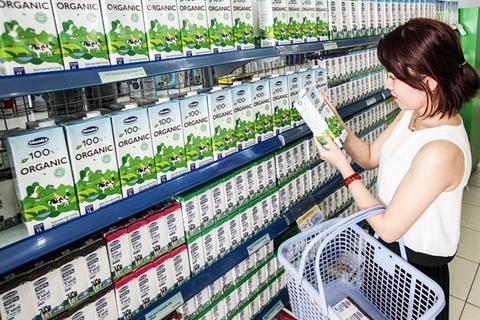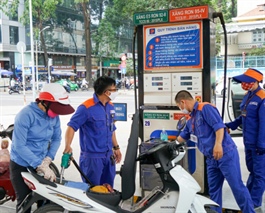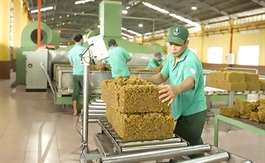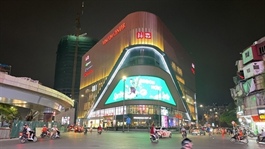Shares end week on negative note, foreign investors return to net buy
Shares end week on negative note, foreign investors return to net buy
Shares ended the week on a negative note amid the cautious sentiment ahead of the resistance level of 1,070 points which made the index struggle.

A customer shops for Vinamilk dairy products. VNM lost 0.9 per cent on Friday. — Photo courtesy of Vinamilk |
On the Ho Chi Minh Stock Exchange (HoSE), the VN-Index lost by 0.12 per cent, to close at 1,067.07 points.
The breadth of the market was negative with 168 gainers and 212 losers. The matching value on the southern bourse reached VND13.3 trillion (US$567.1 million), equal to a trading volume of more than 755.5 million shares.
The VN30-Index posted a drop of 0.18 per cent, to 1,068.84 points. Of the VN30 basket, 16 out of the 30 biggest stocks in market capitalisation on HoSE inched down, while 13 ticker symbols gained and one was flat.
On HoSE, foreign investors returned to net buy a total value of VND1.03 trillion. On the buying side, South Logistics Joint Stock Company (STG) was bought the most with a net buying value of VND1.32 trillion. Vinhomes (VHM) ranked second on HoSE with a value of VND41 billion. Foreign investors also net bought Vincom Retail (VRE) and Khang Dien House (KDH) with values of VND24 and VND16 billion, respectively.
The large-cap group had a less positive performance on Friday.
The stock groups having the worst impact on VN-Index were Vietcombank (VCB), Bank for Investment and Development of Viet Nam (BID), Vinamilk (VNM), Masan Group (MSN), Hoa Phat Group (HPG), Sabeco (SAB), Vinhomes (VHM), Vingroup (VIC) and Becamex (BCM).
In contrast, oil and gas stocks moved up and supported the market, including Viet Nam National Petroleum Group (PLX), PetroVietnam Technical Services Corporation (PVS), PetroVietnam Drilling and Well Services Corporation (PVD) and Drilling Mud Joint Stock Corporation (PVC).
The HNX-Index on the Ha Noi Stock Exchange (HNX) ended the trading day at 213.91 points, a drop of 0.42 per cent.
According to Le Anh Tuan, director of Investment Strategy Planning at Dragon Capital Viet Nam, the stock market is now influenced by two factors: monetary policy and profit growth.
“Monetary policy is following a good direction, but not loosening enough for stocks to grow. On the other hand, profit growth is still restrained, forecasting at around 5 per cent in 2023,” said Tuan.
The cycle of the stock market is divided into three phases: falling, bottoming and recovering – depending on five criteria of interest rates, exchange rates, liquidity, bankruptcy and profit expectations. According to Tuan, with the signal of falling interest rates, stable exchange rates, stable liquidity, and unclear profit expectations, the stock market is gradually moving from the bottom to the early stage of the recovery cycle.
"If investors now still expect the market to drop another 15-20 per cent like in 2022, then I would say that it is unlikely to happen. Because in the context of policy shifting from very tight to relatively loosened, the market's downward momentum might slow down," he said.







































